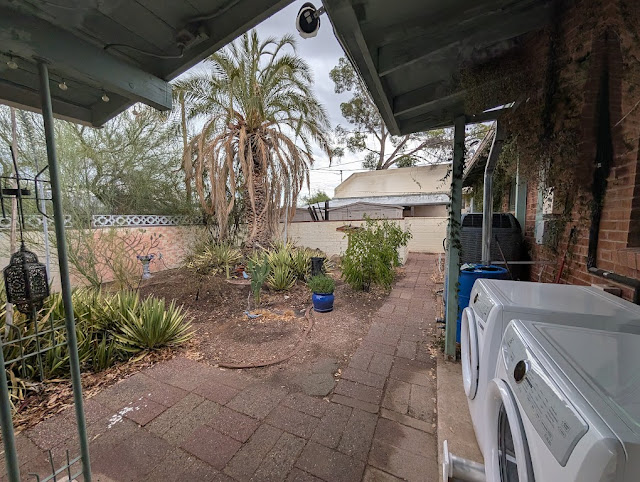Since most of our cisterns have been empty for a while, I was forced to use more city water than I would like to keep my plants alive. I confess that I have even watered our prickly pear when the pads were too emaciated to hold up the flowers.
I've given water to the native chiltepin to perk up the leaves and to the usually resilient rosemary plant that was beginning to yellow. When I saw the signs of leaves finally returning to the hackberry, I gave it some water to help it along. (I try to water them before it gets too hot - or at night - so it doesn't just evaporate.)
Some native plants faired better in these conditions. I didn't have to water the desert broom, palo verde or mesquite at all.
Our durable curry was doing so well, I figured that was one place I could cut back on watering. Wrong. The leaves wilted and yellowed. Lesson learned. I'm back to regular deep watering them with city water.
Then it happened. I used up the last drops of rainwater from our rain barrel.
Now everything was on city water. I just have to keep them alive until monsoon season - in a month?!
Just when I thought it couldn't get any worse - a miracle occurred! It rained! 1/2 inch! In June?!
Dan was out in the rain clearing leaves from the gutter so every last drop of water could fill up the cisterns. Then he reshaped the greywater basin so the water reached the tree. My hero!
Our thirsty basin soaked in the rain. The spiderwort grew and bloomed.
The mesquite boasts green pods. Didn't I notice them before? Or were they just waiting for the rain?
So I'm back to spoiling the pollinators and veggies with rainwater while conserving all the city water I can.
I'm usually more of an advocate for rain basins. But this experience has taught me the importance of having more cisterns to harvest rainwater for the plants in those basins. After hearing my story, a friend shared how she still had rain in her biggest cistern. She urged us to install the cistern sitting in the backyard before the monsoon storms arrive to get us through future dry periods. And so I can plant more pollinators!
OK. Enough belly-aching. Here's some bunnies taking advantage of the moisture by the spiderwort I watered...
I'm usually more of an advocate for rain basins. But this experience has taught me the importance of having more cisterns to harvest rainwater for the plants in those basins. After hearing my story, a friend shared how she still had rain in her biggest cistern. She urged us to install the cistern sitting in the backyard before the monsoon storms arrive to get us through future dry periods. And so I can plant more pollinators!
OK. Enough belly-aching. Here's some bunnies taking advantage of the moisture by the spiderwort I watered...




.jpg)












.jpg)


































